Sometimes it feels like there is nothing on this earth that can make you feel more alive and yet closer to death than a motorcycle. And in all the realm of two-wheeled travel, the most exhilarating, fearsome, and proudest ride toward that feeling might be Ducati's 1299 Panigale. This newest Ducati superbike has been smoothed and refined, but one roaring trip through the gears is all it takes to remember where it came from.
The 1199 Panigale broke new ground when it debuted in 2012. No frame as such, nearly a 2:1 bore-to-stroke ratio, and more acronyms than an infant playing Scrabble. TFT, DES, ABS, and DTC (among others), all designed to keep the rubber side down on an irresistibly sexy superbike. It was also viciously fast and uncompromising, enough so that even the most speed-thirsty moto-journalists walked away with eyebrows raised. Ducati's goal with the new 1299 Panigale was to be all of that, and more. That meant more power, more electronics, more options, and a better all-around motorcycle.
It's easy to look at the 1299 and think the sticker on the fairing is the biggest change, but Ducati has refined and updated most aspects of the bike. The nose of the 1299 is wider—almost exactly halfway between the narrow 1199 and the jowly Superleggera's face—and the windscreen is 20mm taller. A restyled "split" tail is noticeable, too, distracting from 4mm-larger exhaust pipes and a reworked silencer slung under the bike's belly. Keen eyes will have spotted a thicker seat born from 899 success, as well as footpegs suspiciously similar to those on the Superleggera, both of which are welcome updates (more on that later).
And that’s just the stuff you can see. Under the skin, the steering head angle has been steepened half a degree to an even 24 degrees, and the swingarm pivot has been lowered 4mm to match the lowest setting of the adjustable unit from last year’s 1199 R. Lean-angle-dependent ABS joins the array of features, as does an auto-blip downshift option for the quick-shifter function; with it, the bike matches revs automatically during clutchless downshifts.
The up-spec S model we tested comes with Öhlins suspension front and rear—an NIX30 fork and TTX36 shock, as with the previous 1199 S and R—now updated with Ohlins’ latest mechatronic technology. Electronic adjustability for compression and rebound settings remains, but semi-active, “event based” damping control has been added to the Swedish brand’s top-of-the-line offering. In short, the 1299 can tell when you’re accelerating, braking, or turning, and adjusts the suspension accordingly. How?
New for Ducati in 2015 is the IMU, standing for Inertial Measurement Unit, and it is to motorcycling in 2015 what the term ECU was many years ago—in other words get used to IMUs, because soon many more bikes will have them. The unit essentially measures how the bike is leaning, pitching, and accelerating, and gives the data to the 1299’s brain to process. Data regarding lean angle, for example, is processed by the ABS, wheelie control, and the Öhlins suspension systems to change allowable rates of deceleration, acceleration, and fork/shock movement, respectively.
So, does it work? Do all of these revised parts and abbreviations draped over the flagship Panigale actually make it a better bike? Yes.
From a pure performance standpoint, the extra 87cc (through an increase in bore) creates more power, plain and simple. More importantly, Ducati claims that from 5,000 rpm to 8,000 rpm the new engine averages 15 percent more torque than the old powerplant. The result is that the 10 more horsepower—now a claimed total of 205 at 10,500 rpm, and 106 pound-feet of torque—has a slightly more linear delivery, while maintaining the vicious top-end rush that defines the Superquadro V-twin. In short, it’s as blindingly fast as ever, if not more so.
Chassis updates check out too. The steeper steering-head angle has kept the biggest Panigale agile and light to the touch without making it nervous. Flicking the 1299 from side to side it behaves impeccably, with precision and lots of grip. It feels stiff, but appropriate for lapping tracks quickly, and not uncomfortable in fast, sweeping corners. Lowering the swingarm pivot has mitigated some of the nasty rear-end, slip-then-grip, suspension pump that we experienced when previous Panigales searched for traction on corner exits. The 1299 squats slightly more when power is applied driving out of corners, and feels more stable while doing it.
Moreover, the truly aggravating things about the 1199 have been fixed; namely the rock-hard seat and horribly slippery cast footpegs. The seat will mostly contribute to making the 1299 a better street bike, but in our opinion detracts very little from the superbike feel on track. The Superleggera foot rests fitted to the 1299 are such a huge and obvious improvement, it almost makes us tear up. Think we’re exaggerating? Wrangle 200 claimed horsepower around a track with sketchy pegs and you’ll agree.
So yes, fundamentally the 1299 has been made better.
However, whether you like it or not it’s the growing array of electronic adjustments and rider aids that keep the latest Panigale relevant. The aforementioned data-serving IMU is a key component, allowing the 1299 to understand (on a basic level) what situation it’s in and help the rider navigate more smoothly. The Öhlins suspension has two channels, Dynamic and Fixed. Dynamic adjustability consists of five settings, front and rear, that can be adjusted independently; Softest, Softer, Default, Harder, and Hardest. Each setting provides a bracket of rider preference, inside which the suspension adjusts as the bike is ridden. IMU information is used to determine whether the motorcycle is cornering, braking, or accelerating, and react accordingly. That is, stiffen the shock when driving out of a corner or stiffen the fork under braking, as examples.
Similarly, ABS intervention is altered based on lean-angle data from the IMU. With more lean the 1299 “knows” that less brake can safely be applied, based on parameters loaded into the motorcycle’s system, and so decreases the chance of over braking when entering a corner. With perfect weather and ultra-sticky Pirelli Supercorsa SC2 tires mounted for our day at the racetrack it was difficult, if not inadvisable, to experiment with lean-angle ABS technology. Incidentally, the IMU does not influence traction control involvement. The 1299’s TC system has been configured for the new engine’s power delivery, but the algorithms for intervention are the same as the 1199 model.
Of the systems we were able to test thoroughly, some work better than others. DWC, or Ducati Wheelie Control, didn’t win our hearts. The system is eight-way adjustable (nine if you count “off”), the higher the number the more intervention. It seemed to struggle with consistency, though. Level 8 clearly allowed less front-wheel lift than setting 1, but we couldn’t find a sweet spot that contained the bike’s tendency to snap up wheelies while allowing smooth acceleration. Realistically it can’t be fully trusted as a performance feature, and experienced track riders will want to turn it off and modulate wheelies manually.
Conveniently, DWC can be adjusted on the fly via paddles mounted near the left handgrip. Before embarking, the rider can select which component to adjust with the paddles, either DWC, traction control (also eight settings), or engine braking characteristics (three settings). As handy as the paddles are, being able to fiddle with more than one setting at a time would be nice.
Other pieces need no further development. The DQS (Ducati Quick Shift) system’s new auto-blip downshift function is brilliant. A gear- and rpm-specific map for the automatic throttle blips means the bike reacts differently for shifts in higher gears than lower ones, compensating accordingly for the change in ratio from gear to gear, providing the perfect downshift sans clutch lever. It’s perfect for track use, and spoiled us immediately.
At the end of a wheelie-ridden, tire-melting day it’s all of the small changes that make the 1299 more user friendly and therefore a more realistic competitor in today’s showroom power struggle. We can conclusively say that the 1299 is a more complete motorcycle than its predecessor, and we can also confirm it comes at a price. Specifically, an MSRP of $24,995 price for the up-spec S. For $19,295, you can have the base model, which is fitted with a lowly, un-electronic Sachs shock, a 50mm Marzocchi fork, and cast (rather than forged) wheels.
It should be clear by now that Ducati isn’t changing its tune. Yes, it’s an expensive motorcycle, but it also delivers what Ducati customers have long enjoyed; a bold statement. Where some superbikes can be polite and gracious when asked, the Panigale is brash and boastful. It always seems to be glaring around the garage, looking to pick a fight. And that’s good, because 2015 is going to make for one heck of a superbike bout.











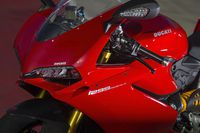


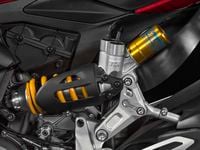
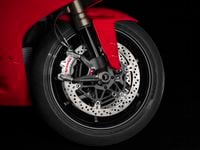

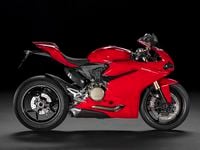
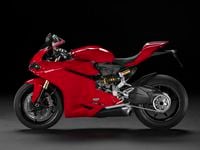



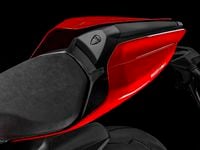
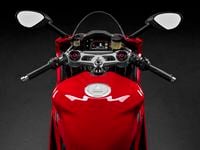

/cloudfront-us-east-1.images.arcpublishing.com/octane/MUQLOVLL2ZDGFH25ILABNBXKTI.jpg)
/cloudfront-us-east-1.images.arcpublishing.com/octane/TNOU5DNE2BC57MFPMGN2EIDXAM.jpg)
/cloudfront-us-east-1.images.arcpublishing.com/octane/GTCXACQGJ5HAPDTGWUQKDEH44E.jpg)
/cloudfront-us-east-1.images.arcpublishing.com/octane/S35YGSEMEZB4BLTDJTSZPF4GLA.jpg)
/cloudfront-us-east-1.images.arcpublishing.com/octane/5UOT6HPX2JFMRJAX6EH45AR4MQ.jpg)
/cloudfront-us-east-1.images.arcpublishing.com/octane/OKWOJWAKP5EP3OACCRRWPCIX2Q.jpg)
/cloudfront-us-east-1.images.arcpublishing.com/octane/2WF3SCE3NFBQXLDNJM7KMXA45E.jpg)
/cloudfront-us-east-1.images.arcpublishing.com/octane/G4MG6OUCJNBSHIS2MVVOTPX65E.jpg)
/cloudfront-us-east-1.images.arcpublishing.com/octane/IIGGWFOTOJGB7DB6DGBXCCMTDY.jpg)
/cloudfront-us-east-1.images.arcpublishing.com/octane/QSTCM6AVEZA5JJBUXNIQ3DSOF4.jpg)
/cloudfront-us-east-1.images.arcpublishing.com/octane/U4I7G625B5DMLF2DVIJDFZVV6M.jpg)
/cloudfront-us-east-1.images.arcpublishing.com/octane/B6XD6LS6IVCQPIU6HXDJSM3FHY.jpg)
/cloudfront-us-east-1.images.arcpublishing.com/octane/ICL63FEDDRDTTMINYICCEYGMDA.jpg)
/cloudfront-us-east-1.images.arcpublishing.com/octane/FCGZHQXRBZFLBAPC5SDIQLVF4I.jpg)
/cloudfront-us-east-1.images.arcpublishing.com/octane/WNOB6LDOIFFHJKPSVIWDYUGOPM.jpg)

/cloudfront-us-east-1.images.arcpublishing.com/octane/X33NU3E525ECRHXLNUJN2FTRKI.jpg)
/cloudfront-us-east-1.images.arcpublishing.com/octane/6KKT5NNL2JAVBOXMZYS5ZO76YA.jpg)
/cloudfront-us-east-1.images.arcpublishing.com/octane/J5RKG5O455GMPGQRF2OG6LRT7A.jpg)
/cloudfront-us-east-1.images.arcpublishing.com/octane/GX2CIZKQVRH2TATDM26KFG2DAE.jpg)
/cloudfront-us-east-1.images.arcpublishing.com/octane/ZWIDYSAKQZHD5BHREMQILXJCGM.jpg)
/cloudfront-us-east-1.images.arcpublishing.com/octane/CYUHJZCTSJCH3MRAQEIKXK7SCQ.jpg)
/cloudfront-us-east-1.images.arcpublishing.com/octane/LKOFINY56FCXJCANJ5M7ZDQUBY.jpg)
/cloudfront-us-east-1.images.arcpublishing.com/octane/4NBPDACMWJH63JQYJVK3QRBDZI.jpg)